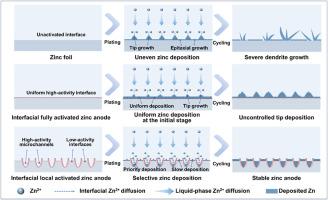Interfacial local activation strategy tailoring selective zinc deposition pattern for stable zinc anodes
IF 12.7
1区 材料科学
Q1 ENGINEERING, MULTIDISCIPLINARY
引用次数: 0
Abstract
"Tip effect" triggered by uneven zinc deposition accelerates the growth of Zn dendrites. The unfavorable interfacial activity gradient aggravates zinc deposition at the tips, which is the root cause of zinc dendrites. This study reports an interfacial local activation strategy to reconfigure the interfacial activity gradient of zinc anode to promote more stable operation of zinc batteries. A locally activated zinc anode (Zn-ILA) is proposed as the proof-of-concept zinc anode by constructing high-active microchannels to induce preferential zinc deposition, while the remaining low-active region is accompanied by zinc epitaxial growth, thus achieving bottom-up zinc deposition at the anode interface. A fabrication method based on nanosecond pulsed laser is used to modify the zinc anode by creating high-active microchannels through thermal impingement. Additionally, low-active regions covered by dense ZnO nanoparticles are also formed due to the plasma effect. The laser-induced cross-scale oxide layers help improve the corrosion resistance at the full zinc anode interface. The proposed interfacial local activation strategy enables ordered selective deposition at the Zn-ILA interface owing to the activity gradient, as well as stabilizes the long-term operation of symmetric and full cells. The effectiveness of Zn-ILA is also validated in large-area pouch batteries, showing great potential for large-scale energy storage systems.

定制选择性锌沉积模式的界面局部活化策略,实现稳定的锌阳极
锌沉积不均匀引发的 "尖端效应 "加速了锌枝晶的生长。不利的界面活性梯度加剧了锌在尖端的沉积,这是产生锌枝晶的根本原因。本研究报告了一种界面局部活化策略,用于重新配置锌阳极的界面活性梯度,以促进锌电池更稳定地运行。研究提出了一种局部活化锌阳极(Zn-ILA)作为概念验证锌阳极,通过构建高活性微通道来诱导锌的优先沉积,而剩余的低活性区域则伴随着锌的外延生长,从而在阳极界面实现自下而上的锌沉积。基于纳秒脉冲激光的制造方法通过热冲击形成高活性微通道,从而对锌阳极进行改性。此外,由于等离子体效应,还形成了由致密氧化锌纳米颗粒覆盖的低活性区域。激光诱导的跨尺度氧化层有助于提高全锌阳极界面的耐腐蚀性。由于活性梯度的存在,所提出的界面局部活化策略能够在 Zn-ILA 界面实现有序选择性沉积,并稳定对称和全电池的长期运行。Zn-ILA 的有效性在大面积袋式电池中也得到了验证,显示了其在大规模储能系统中的巨大潜力。
本文章由计算机程序翻译,如有差异,请以英文原文为准。
求助全文
约1分钟内获得全文
求助全文
来源期刊

Composites Part B: Engineering
工程技术-材料科学:复合
CiteScore
24.40
自引率
11.50%
发文量
784
审稿时长
21 days
期刊介绍:
Composites Part B: Engineering is a journal that publishes impactful research of high quality on composite materials. This research is supported by fundamental mechanics and materials science and engineering approaches. The targeted research can cover a wide range of length scales, ranging from nano to micro and meso, and even to the full product and structure level. The journal specifically focuses on engineering applications that involve high performance composites. These applications can range from low volume and high cost to high volume and low cost composite development.
The main goal of the journal is to provide a platform for the prompt publication of original and high quality research. The emphasis is on design, development, modeling, validation, and manufacturing of engineering details and concepts. The journal welcomes both basic research papers and proposals for review articles. Authors are encouraged to address challenges across various application areas. These areas include, but are not limited to, aerospace, automotive, and other surface transportation. The journal also covers energy-related applications, with a focus on renewable energy. Other application areas include infrastructure, off-shore and maritime projects, health care technology, and recreational products.
 求助内容:
求助内容: 应助结果提醒方式:
应助结果提醒方式:


